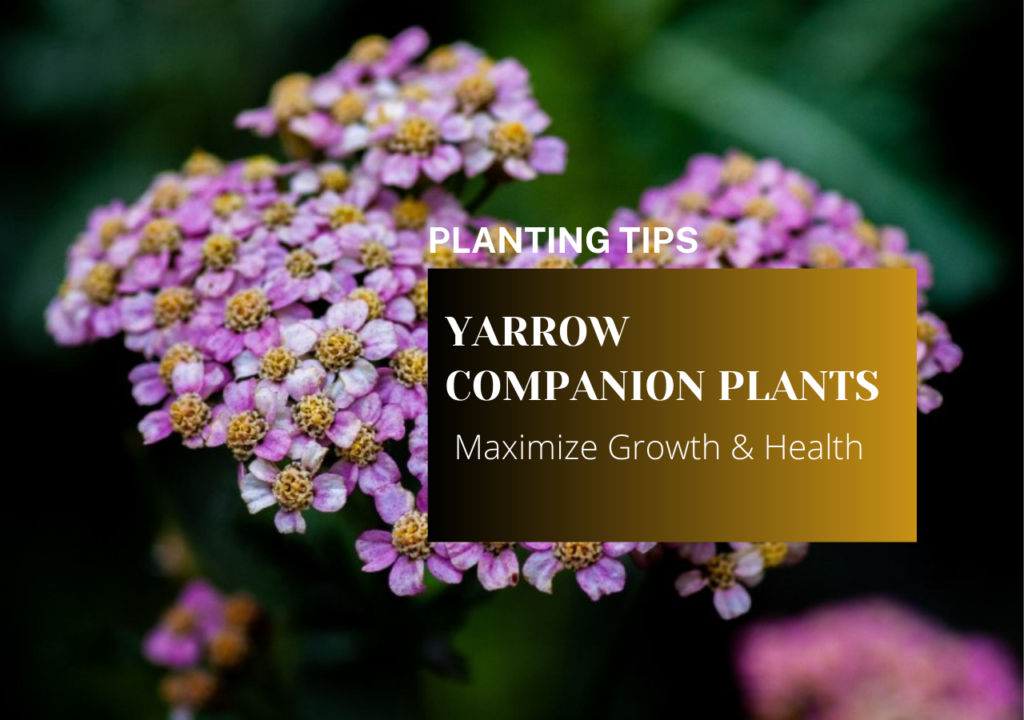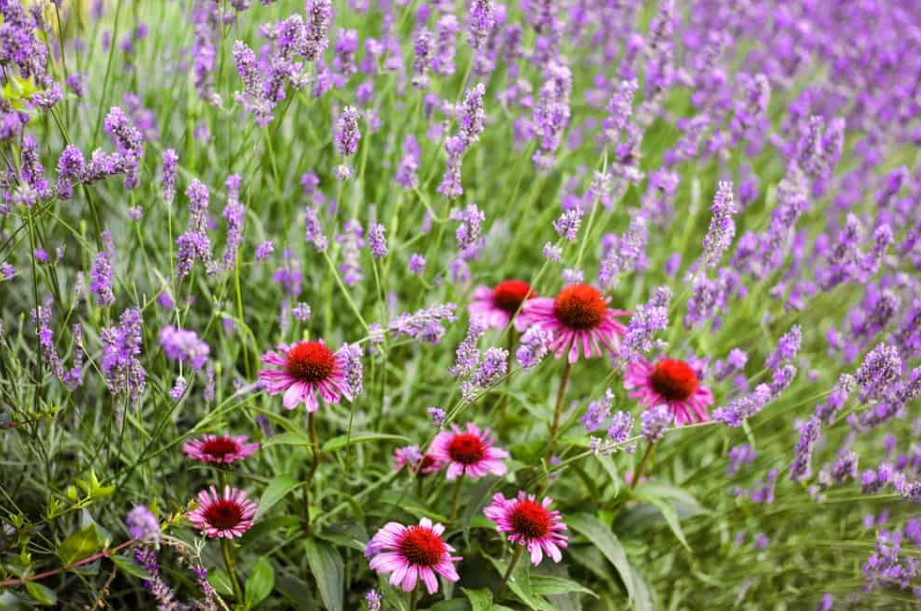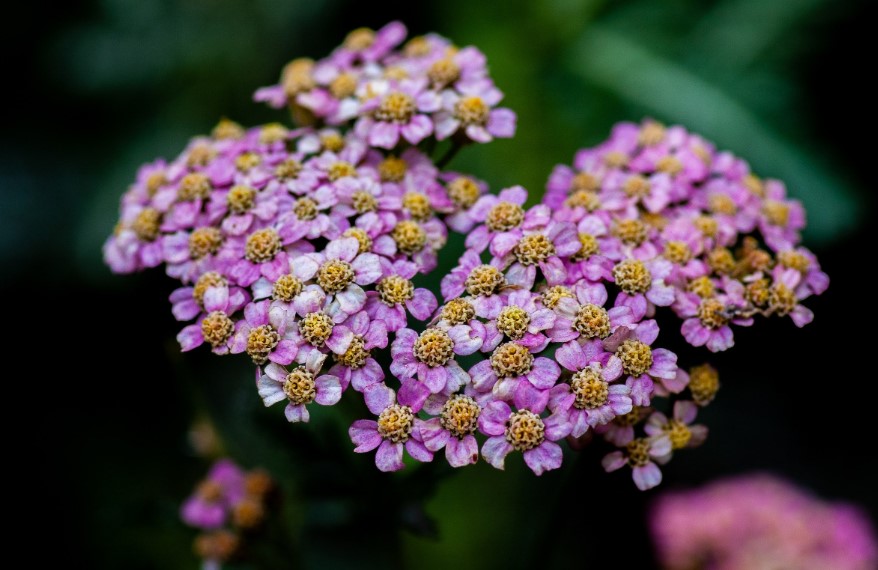With strategic garden planning, consideration of companion plants can sometimes be the key to optimal growth and sustainability. In talking about gardening, ‘yarrow companion plants’ is one captivating area where synergism within flora is very much part of the relationship.
Yarrow has been praised for many properties, including its own growth and creating a positive atmosphere for those plants that grow around it. As we consider some of the yarrow companion plants, one finds a tapestry of interconnected benefits and complexities that paint a pretty picture of harmonious botanical coexistence.

Yarrow Companion Plants: Benefits
Yarrow companion plants serve many purposes within an ecosystem. The primary use of yarrow is repelling most insects and pests while attracting the kind that would be beneficial, such as ladybugs and hoverflies. Due to their nature, that keeps the pests away, yarrow creates a much more conducive environment for any other plant that is growing nearby, hence it is good in any companion garden.
Its deep-reaching roots also help to break up compacted soil and generally improve soil structure for nutrient uptake, which benefits yarrow, but its immediate neighbors, too. By acting to draw up many of the important nutrients and minerals from the soil, yarrow is a nutrient accumulator, wherein it builds up in the plant, enhancing the area around itself and serving to help other plants maintain vigorous growth.
In addition to that, companion plants of yarrow become more vigorous and resistant to disease. Organic substances and essential oils emitted by yarrow contribute to some sort of barrier for plants that grow around, hence making them resistant to easily acquiring diseases, which is healthy for the neighbors. This kind of symbiotic relationship creates a garden ecosystem in perfect balance where everything flourishes with the presence of yarrow and its companion plants.
The Best Companions for Yarrow
Yarrow is one of those plants that just flourishes with companion planting to encourage healthy growth and natural pest repellence. Some of the best companions for yarrow are sweet-smelling herbs like lavender and thyme, which attract beneficial insects and give an aromatic background to the garden. Besides, growing yarrow among flowers like echinacea and daisies attracts pollinators and enhances biodiversity in your garden.
Another fine companion planting for yarrow would be flowers akin to yarrow in appearance, such as its aster family relatives: asters and daisies. These flowers offer a highly attractive flower display, similar in appearance. Nitrogen-fixing plants should be included, such as clover, that will help enrich the soil for better health of yarrow and its companions. This develops a very symbiotic relationship between all the plants.
Consider adding a few ornamental grasses to your yarrow companion planting plan, such as fountain grass or blue oat grass. These grasses add an attractive contrasting texture and color while helping to act as a natural mulch to help retain moisture and suppress weeds. When you choose a few select plants that complement the characteristics of yarrow, a balanced and disease-free ecosystem is possible.

How Yarrow Supports Plants Around It
Yarrow is an excellent addition to any companion planting scheme due to its very multi-faceted role in supporting other plants. This perennial herb enhances the health and vigor of other plants through the action of having deep, fibrous roots that greatly improve the structure of the soil and the nutrient availability. It serves as a natural fertilizer because it pulls up essential minerals from the soil, thereby enriching nearby plants with its nutrient-rich presence.
Besides this, yarrow’s strong fragrance keeps some pests away, thus protecting nearby plants from them. This is a plant with a strong scent that bugs cannot find due to the highly confusing surrounding fragrance-which makes it one of the important companions in organic methods of dealing with pests. Moreover, the dense foliage of yarrow shades and covers the ground, which tends to inhibit weeds from growing and prevents water loss in the soil, therefore creating better conditions for the development of plants around it.
Additionally, yarrow is said to attract useful insects such as ladybugs and hoverflies, which prey upon common garden pests like aphids. In hosting these beneficial insects, yarrow plays an indirect role in pest control for the garden ecosystem while putting all the plants around it in a state of harmonious balance. Overall, such a multi-dimensional support system provided by yarrow turns it into a valuable ally in fostering health and well-being among its companion plants and furthers a thriving and sustainable garden environment.
Planting Methods for a Successful Yarrow Companion Garden
Planting a successful yarrow companion garden requires plants that prefer to grow under the same conditions as yarrow. This would include plants such as lavender and sage, along with dill, as great companions to have because it not only looks nice being planted together but also has many other advantages, including controlling pests and furthering pollination. Allow proper spacing between plants to prevent overcrowding, allowing for competition in resources, which promotes overall garden health.
Also, consider the sun requirements for each of these species so that they receive proper light exposure. For instance, yarrow prefers full sun, though it will tolerate partial shade, so plant accordingly. Regular watering is important, but do not overwater, as yarrow is fairly drought-tolerant once established. Apply organic mulch around plants to retain moisture in the soil and suppress weeds. This will encourage a healthy ecosystem for your yarrow companion garden.
Employ intercropping and companion planting circles to minimize space while optimizing the space for better plant-plant interactions. Intercropping yarrow with some of the companion plants will be a good way to ensure diversity in the garden ecosystem for more resilience, increasing biodiversity, and minimizing the possibilities of pest infestation. Try experimenting with various combinations of plants to find harmonious and productive arrangements for your yarrow companion garden. Don’t forget to check up on the growth and health of your plants from time to time to avoid unexpected issues and to keep your garden healthy throughout the year.
Common Pests and Diseases in Yarrow Companion Planting
Even though yarrow companion planting offers quite a few benefits, it still gives one a few possible pests or diseases to be aware of. A number of common problems in usual yarrow companion planting include the following:
Aphids: These tiny insects can cluster on yarrow plants, sucking sap from the leaves and causing damage. To control aphids, consider introducing natural predators like ladybugs or using insecticidal soaps.
Powdery Mildew: Yarrow is susceptible to powdery mildew, a fungal disease that appears as a white powdery substance on the plant. Ensure good air circulation and avoid overhead watering to prevent this issue.
Monitor your yarrow companion plants regularly for these common pests and diseases. If you stay vigilant, with early intervention when needed, this can ensure a garden ecosystem that is healthy and keeps on thriving.
Aphids
Other common pests that may well invade yarrow or its companions include aphids. These soft-bodied, tiny insects feed by sucking on plant juices, causing leaves to distort and curl. Perhaps an equally important sign of infestation is the sticky covering left behind as honeydew, attracting ants and accommodating the growth of sooty mold.
For yarrow companion planting aphid control, organic treatments can be done by hatching ladybugs or lacewings. Or one can simply mix up a mild soap and water solution in order to make an insecticidal soap spray that will not harm any beneficial insects. Check plants regularly for early signs of aphids before an infestation is present to prevent widespread damage.
Other ways to potentially avoid aphids are by not over-crowding and stressing the plants, regular watering, and having good sunlight. Planting fennel, dill, or basil as a companion crop will attract useful insects feeding on the aphids as a biocontrol into the yarrow garden. By following these methods, you will protect your yarrow from predators and create a healthy, bio-resistant companion garden complex.
Powdery Mildew
Powdery mildew is one of the fungal problems that normally assail yarrow and its companion plants. It is a white powdery growth on the leaves that limits photosynthesis, hence weakening the plant. As a result, it can easily take hold where air movement is poor and when there is humidity. As a result of this, good garden hygiene is required for maintaining yarrow’s companion plants.
Plant yarrow and its companions in well-sunned areas that have good air circulation to help combat powdery mildew. Avoid overhead watering; having moisture on the leaves will encourage the fungus to spread. Prune immediately any affected parts to lessen the chance of this infection getting worse. Organic methods of treating powdery mildew include neem oil or a baking soda solution.
In this regard, early indications of powdery mildew in your garden are reduced if the garden is regularly examined for severe outbreaks of this disease. This beautiful garden landscape, yarrow and its companions, will maintain its health and vigor through good cultural methods of gardening and proactive diseases’ management.
Yarrow and Companions: Some Tips on Harvesting and Maintenance
Proper harvesting and techniques for maintaining a healthy yarrow companion garden are accomplished by paying attention to details concerning longevity and vitality. Regular pruning will help to prolong the life of yarrow and those plants that complement it. Remove dead or faded flowers to accommodate new growth and to retain the beauty of your overall garden.
Further, in relation to yarrow and all its companion plants, methods of drying and preserving become very important in order for them to be used even out of their season. Yarrow shall be harvested when flowers are completely opened and should be processed with proper drying techniques so that they can be used later on in arrangements or for herbal purposes. Save them by putting them in a cool, dry area.
Also, get into a habit of inspecting your yarrow and its companions regularly for pest infestations or disease. Early detection of some of the commonest problems likely to affect them, such as aphids or powdery mildew infestations, will prevent widespread problems or only affect those plants that might have been reached. In so doing, you remain attentive to your maintenance tasks, ensuring years of health and longevity in your yarrow companion garden.
Pruning Tips
Pruning Parameters for Yarrow and its Companion Plants: This therefore is very important in maintaining its health and encouraging health and vigour. Here are some of the key things that you should be keen on when pruning your yarrow garden:
Prune yarrow plants in the early spring to remove any dead or damaged foliage and promote new growth. Use sharp and clean pruning shears to make clean cuts without causing unnecessary stress to the plants.
Trim back yarrow blooms after they fade to encourage continuous flowering and prevent the plant from diverting energy into seed production. Deadheading spent flowers also enhances the overall appearance of the garden.
Avoid over-pruning yarrow, as these plants thrive with minimal maintenance. Focus on removing only the necessary parts to maintain a balanced and healthy growth habit. Additionally, regular inspection for pests and diseases during pruning can help prevent potential issues.
When pruning companion plants around yarrow, ensure that they also receive adequate airflow and sunlight. Tailor the pruning techniques based on the specific requirements of each plant species to create a harmonious and thriving garden ecosystem.

Drying and Preserving Methods
Yarrow and its companion plants need to be dried and preserved properly if their medicinal properties are to be retained and shelf life extended. After being gathered they should first be tied in bundles and hung upside down, drying naturally in a warm, dark area with good ventilation in order to preserve the colour and aromatic properties of the plants.
Preserve yarrow and its companions by making them into herbal sachets or infused oils. Make pleasant-smelling sachets to hang in the closets or to rest in drawers by filling breathable bags with dried yarrow and herbs. Otherwise, infuse the beneficial properties into oils with dried yarrow and herbs in it for skin care or aromatic purposes.
For maximum preservation, store dried yarrow and companion plants in closed containers away from moisture or direct sunlight. Periodically check the herbs for mold or water accumulation. Any compromised samples should be disposed of. Well-preserved yarrow and its companions can be used throughout the year for various therapeutic and culinary purposes.
Success Stories: Experiences with Yarrow Companion Planting
Many gardeners have championed success stories in the aspect of companionship with the plant. Yarrow combined with echinacea and lavender, they say, improves pollination and infuses general good health into the garden. Indeed, to that effect, they say, “Yarrow interplanted among salvias and agastaches produces a very beautiful combination of colors and textures.
Many also commented that yarrow planted near vegetables, like tomatoes and peppers, repel natural pests because of the pungency of the scent, hence reducing infestation. Others also sang praises about the yarrow border plant for how dynamic it is in often enhancing insects like ladybugs and lacewings that help in ecological balance. These accounts, if anything, are testimony to yarrow’s versatility in a number of companion planting situations.
Yarrow companion plants can create a beneficial ecosystem in the garden. When planted together, they can have improved growth and health benefits from one flora to another. With the right companions chosen, yarrow increases soil fertility and attracts useful insects. Generally, this plant improves plants’ resistance to some adverse conditions. Its aroma repels many pests, making it exceptionally good for the plants that sit next to it, like lavender, chamomile, and dill.
Yarrow serves as a dynamic support system when planted purposefully among other species. The deep roots aerate the soil and draw up nutrients, benefiting the shallower-rooted plants around it. Besides this, the mineral-accumulating capability concerning minerals such as phosphorus and potassium may enrich the soil and thereby feed the life of vegetation around it. Such cooperation by plants leads to a balanced garden ecosystem and promotes biodiversity.
A yarrow companion garden will be successfully built by considering the sunlight requirements, spacing, and watering needs of both yarrow and its companions. Adequate planning and placement of plants can foster the relationships in better ways and keep the garden healthy and more beautiful. Regular monitoring, weeding, and watering practices will maximize yarrow health and productivity, as well as that of its companion plants. By following these methods, gardeners will be able to reap all the benefits associated with a well-thought-out and healthy yarrow companion garden.
In growing a garden enhanced by the merits of yarrow companion plants, you are undertaking an adventure of mutual thriving. You have in this tapestry of yarrow and its companions that blend so well something beautiful and nurturing for the ecosystem in harmonious balance.
Care for this yarrow companion garden, and in time, you too will be a steward of biodiversity and a grower of relationships intertwined in nature’s web. Feel within each leaf the essence of yarrow companion planting, every bloom, and each whisper of wind with the promise of a very bountiful and sustainable sanctuary in your garden.
